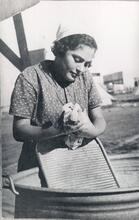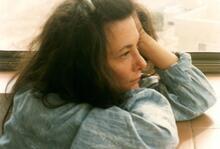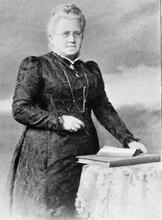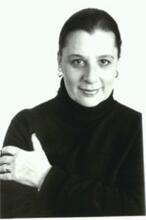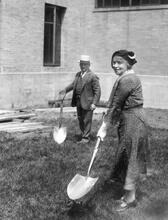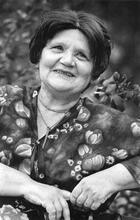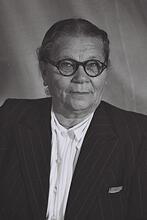Mizrahi Feminism in Israel
In the 1970s, the relationship between Ashkenazi and Mizrahi feminists in Israel followed liberal-radical values, believing in sisterhood and solidarity as well as freedom and equality of all women. But racist and patronizing attitudes common in the larger society were also present in feminist movements, and it took Mizrahi activists more than twenty years to make their voices heard. Mizrahi feminism goes beyond the western scope of feminism to include the history and issues that concern women in the Middle East (Jewish and non-Jewish) in Israel and in Arab and Muslim countries. In this respect, it is particularly sensitive to issues of racism, class division, immigration, and ethnic discrimination; it is often described as an intersectional feminism that focuses mainly on the struggle against gender and ethnic oppression.
Introduction
“Lit. "Eastern." Jew from Arab or Muslim country.Mizrahi feminism” is an expanding term used in feminist discourse and activist feminism in Israel. It stretches the boundaries of Israeli feminism—a feminism that evolved out of the western liberal tradition. Mizrahi feminism embraces the agendas of traditional liberal and radical and post-colonial feminisms, but it goes beyond the western scope of feminist activism and research to include the history and issues that concern women in the Middle East (Jewish and non-Jewish) in Israel and in Arab and Muslim countries. In this respect, it is particularly sensitive to issues of racism, class division, immigration, and ethnic discrimination; it is often described as an intersectional feminism that focuses mainly on the struggle against gender and ethnic oppression.
A main criticism of classical liberal feminism is that it focuses on the liberation and equality of women in their abstract forms and strives for women’s equal access to the public sphere (Susan Okin Moller, 1998), leaving out topics that concern specific groups of women. Critics also argue that liberal feminism’s political inclination is often too abstract, secular, and leftist; economically it is viewed as consistent with a neoliberal agenda, and it employs mainly legal methods. This is to be understood on the ground of Israeli politics, in which neoliberalism and a left-wing inclination collide; the upper class generally consists of Ashkenazi, secular Jews who hold leftist opinions, while traditional Mizrahim are politically more right-wing. As a result, it often overlooks marginalized women of various categories, such as women of color, women with special needs, and other minorities. Radical feminism differs from liberal feminism in employing more militant methods to achieve similar goals; it is also considered problematic because it targets mainly the WASP population. Israeli feminism in its first steps was unclear about its agenda. On the one hand, it was an imitation of US feminism because it was established by US immigrant women in the 1970s; on the other hand, this model was not fully applicable to the Israeli social and political structure or responsive to Israeli women’s needs. Hence in the early days it was impossible to determine what was liberal and what was radical. Israel’s complex social structure and its preoccupation with security and religious politics shaped the trajectory of Israeli feminism beginning in the 1970s.
Mizrahi feminism split off from “Israeli feminism,” considering Israeli feminism to be in essence “Jews of European origin and their descendants, including most of North and South American Jewry.Ashkenazi feminism” because most of its activists were white Jewish women of European origin. Mizrahim, who originate in North Africa and the Middle East, were seen by Zionists after their migration to Israel as an aggregated group of “Bnei Edot Hamizrah” (children of Mizrahi ethnic groups). Their specific histories, languages, and cultures vanished from Israeli history and curricula, and they were treated as one ethnic group in the eyes of the Zionist absorbing authorities, who aimed to melt all Jews in one Jewish national pot. Only in Israel is one “a Mizrahi,” rather than Yemenite, Moroccan, Iraqi, etc.
A tense and conflictual Mizrahi/Ashkenazi relationship became a significant aspect of an Israeli history marked by orientalist perceptions of superiority and patronization (Edward Said, 1979). Mizrahi feminism is the women’s chapter of this tension, which intersects with the liberal feminist agenda and shapes the Mizrahi-Ashkenazi relationship. Until the 1970s (prior to large-scale immigration from the former Soviet Union and wealthy western countries), 50% of women in Israel were Mizrahi. In the 1970s and 1980s it became difficult to determine the number of Mizrahi women in Israel, due to immigration and increasing rates of intermarriage between Jewish ethnic groups. Although relationships between Mizrahim and Ashkenazim have improved, the tension refuses to vanish entirely (Dahan-Kalev, 2001.)
The emergence of Mizrahi feminism
In the 1970s, Jewish feminists migrated from the United States, bringing with them ideas from the American women’s liberation movement. Together with Israeli Ashkenazi women, they formed a feminist movement in the liberal-radical spirit and began to promote their agenda, joined by a few Mizrahi feminists attracted by their slogans of liberation, sisterhood, and solidarity.
From the beginning the Mizrahi feminists experienced patronization, exclusion, and discrimination, as Hanita Raz, one of the activists, reported (Raz, 1983.) They learned that problems they recognized as Mizrahim outside the movement infected feminist activity as well. As Ramazanoglu (2002) put it, feminists’ class interests generally outweigh sisterhood and solidarity; in a choice between a low-priced dress produced by an exploited woman and a more expensive, ethnically produced item, they purchase the less expensive dress. Ashkenazi feminists favored their middle- and upper-class interests, rather than their lower-class sisters—most of whom were of Mizrahi or Palestinian origin. Within feminist organizations, stereotypes and prejudice about Mizrahim were common.
In this respect the new feminist movement was no different from the older, more conservative women’s organizations WIZO and NAAMAT. Of upper-middle-class origin, many Ashkenazi feminists were affiliated with powerful elites, including figures such as daughters of a former chief of staff or a university chancellor or spouses of celebrities; this status enabled them to access resources and use power to promote their agenda. The Mizrahi feminists, by contrast, were far from these circles and had very little power to offer (Dahan Kalev, 2001). Ashkenazi feminists were impatient when Mizrahi women tried to express these asymmetrical relations. They moved on, leaving behind those who disagreed or advocated a more diverse agenda. In events such as annual conferences and parades, Ashkenazi feminists always took the most prestigious activities, leaving Mizrahi feminists the dirty work of distributing fliers, recruiting members, and writing reports. Still believing in sisterhood, Mizrahi women hoped this state of affairs would change, but they were proven wrong and felt growing alienation, racialization, and bitterness (Eliezer, 1996; Dahan-Kalev 2001; Seri, 1983; Seri 1984; Raz 1984.)
It took Mizrahi feminists more than 25 years to find their voices and begin expressing their opinions about the aggravating situation. In that time feminists met once a year in a gathering they called “the feminist movement.” But it was not yet a movement or a well-organized feminist body. The organizations were still in formation, by women from upper-middle-class strata who considered themselves feminists. In 1994, in the communist A voluntary collective community, mainly agricultural, in which there is no private wealth and which is responsible for all the needs of its members and their families.kibbutz Givat Haviva where the annual conferences usually took place, a handful of Mizrahi feminists burst onto the stage where the main speech was being given on a Friday night, demanding that oppression and racism against Mizrahi and Palestinian lower-class participants be dealt with immediately. About a dozen of leading Mizrahi figures including Netta Amar, Henriette Dahan-Kalev, and Tikva Levi refused to leave the stage and the program stopped. The Ashkenazi feminists, deeply hurt, accused the Mizrahi women of ingratitude. The long-silenced tension surfaced, and bitterness on both sides soured the atmosphere. Many of the more radical Mizrahi feminists left the movement, while others, including the prominent figure Vicki Shiran, favored compromise and remained. Most of those in favor of compromise were better off and better educated and lived in Tel Aviv, while the more militant came from more peripheral areas.
Establishing a Mizrahi feminist movement
In 1995, the group that left the broader feminist movement organized the first Mizrahi feminist conference in Natanya. In 1999 they met again for a conference in Shlomi, a peripheral town in the north, and formed “The Year of The Women Workers” project and the “Mizrahi Feminist Movement for Women Workers.” The following year they renamed the movement “Ahoti (My sister) - The Movement of Mizrahi Women.”
From the start, the Mizrahi activists concentrated on issues of concern to marginalized women. They focused first on the situation of women in Israeli sweatshops and textile factories, where most of the workers were Mizrahi and Palestinians, encouraging them to organize and fight for their rights. In 2001 a group of Mizrahi women in a textile factory in the southern town of Mitspe Ramon rebelled against the factory owners, and Ahoti was the first to be there and support them (Dahan-Kalev, 2018). The movement raised funds and organized as an NGO, whose agenda includes diverse issues and changes according to the membership and leadership, as will be elaborated further below. However, the Mizrahi feminist agenda that was forming applied itself economically to lower-class women and culturally to recovering from ethnic and racial deprivation. It is based in the poor southern area of Tel Aviv and is open to all women who need help and consultation.
Mizrahi feminism was thus born out of distinctiveness and separation from Ashkenazi feminism based on the experience of discrimination, but it formed its agenda around issues of concern to marginalized women and focused on socio-economic needs and welfare issues. The movement also focuses on the problematic relationship between Mizrahim and Ashkenazim. Mizrahi feminists focus on issues typical for women and the cultural, political and ethnic matters that concern women of Mizrahi origin (Dahan-Kalev, 2001, 2014.)
A few years after the Ahoti Mizrahi activists split from the Ashkenazi-dominated feminist movement, the relationship with Askenazi feminists began to stabilize and normalize. Both sides realized that even if sisterhood is only an unachievable ideal, pragmatic cooperation on specific short-range issues can benefit both sides. Some issues, however, continue to be addressed separately, as discriminatory practices remained. Mizrahi feminists still report being patronized, even if under the cover of politically correct discourse. The feminist agenda continues to evolve as younger generations join.
The death of the welfare state and implications for the feminist agenda
Since 1996, Mizrahi feminists have reacted to many changes, developing strategies, debating priorities, opening their doors to younger generations, and writing new chapters of their history from their own point of view (Ella Shohat, 2001). Mizrahi feminism’s first phase, beginning in 1996, focused on recovering from multifaceted deprivation and on in-movement empowerment. Feminists met in intimate fora, looking for the remnants of repressed legacies and attempting to undo the Gordian intersectional knots that combined Mizrahi and gender problems. Traumatized since immigrating to Israel as daughters of exploited and excluded Mizrahi parents, they prioritized issues of poverty and exploitation of women, single mothers, and social injustice. But these were interwoven with cultural and ethnic factors. This combination places Ashkenazi and Mizrahi women on two sides of the fence of the welfare state.
Middle-class Ashkenazi women are often career-oriented, but they maintain the traditional gender division of labor in which spouses do not share housekeeping equally and so must purchase assistance from outside the family. Since the 1970s, groups of marginalized women, including Russian and Ethiopian immigrants, asylum seekers, and other immigrant workers, have joined Mizrahi women in seeking jobs in child care and household work. These jobs are often poorly paid and demand heavy manual labor. Marginalized women thus often meet Ashkenazi women from the other side of the labor market fence, in employee-employer relationships.
Marginalized women, with lower levels of education, often work in two shifts, first in sweatshops or household and child care jobs and second in their own homes. Facing difficulties caring for their own children, they are trapped in the circle of needing help from social workers and welfare programs. Because most of the educators, social and welfare workers, and psychologists are Ashkenazi women, Mizrahi and Ashkenazi women again meet on opposite sides of the fence in the welfare services domain. The encounter is hierarchical, with the Ashkenazi women holding power over Mizrahi and other categories of women and their children and families. Ashkenazi women come to these fields, just as they came to the feminist movement, steeped in stereotypes and prejudices that unfortunately occasionally result in abuse of power (Eliezer,1996).
With the death of the welfare state in the 1980s, neoliberal policies deepened the economic problems of marginalized women. Embracing globalization, the Israeli state opened the market to contractor companies such as in the textile and food industry, the main labor force consists of Mizrahi and Palestenian women. Later, Russian immigrants and Ethiopian immigrants joined them, paid even lower wages. These companies demanded longer working hours, and deprived workers of basic welfare rights. These circumstances fostered household neglect and lack of proper child care in many working-class families. Many of these women, single mothers whose social rights were violated, had difficulties paying rent and found themselves on the streets.
Mizrahi feminists began developing strategies to support marginalized women on specific issues, focusing especially on single mothers. In one well-known example, in 2003 Vicki Knafo marched 200 kilometers from the town of Mitzpe Ramon to Jerusalem to express her discontent with the Ministry of Finance’s cuts to allowances to single mothers. Mizrahi feminists were first to join her protest. Similarly, they supported sex-trafficked women and victims of drugs and violence against women (Dahan-Kalev, 2019).
Since the establishment of Ahoti, Mizrahi feminists have developed projects in which unemployed marginalized women could engage, such as catering, Ethiopian crafts, marketing Bedouin embroidery, exhibitions of Mizrahi and Ethiopian arts, Palestinian-Jewish theater performances in poor quarters of Jaffa, and cooperation between Palestinian and Jewish women in other villages and cities. All operated in fair-trade mode. Ashkenazi and Mizrahi feminists cooperated in some of these projects (Dahan-Kalev, 2019).
Paradoxically, Mizrahi women reported that the more they improved their status, the more they discovered how far from equality they were. Even women who were academically successful or who developed careers still found themselves lagging behind Ashkenazi women. A few Mizrahi women made it to the top in sectors such as the IDF, government positions, and academic or business careers, but many reported that they had to turn a blind eye to instances of ethnic discrimination and sexual harassment. Other women who “made it” moved up the ladder due to mixed marriages or were able to move from the peripheral areas of Israel to the center, mainly to Tel Aviv. Thus geography, marriage, and denial of “mizrahiness” hide Mizrahi-Ashkenazi tension but do not abolish it. In this respect, Ashkenazi and Mizrahi feminist tension mirrors the larger socio-economic and cultural divide in Israel (Dahan-Kalev, Haaretz, July 28, 2012; Dahan-Kalev, 2001; 2018; 2019).
The cultural and traditional divide
The cleavage between Mizrahi and Ashkenazi women is felt in other domains too, particularly their different histories, cultures, and religious practices. Mizrahi women were generally educated in homes with traditional Mizrahi lifestyles, often referred to in English as Sephardi. Jewish communities in Arab and Muslim countries had often found ways to intertwine religion, tradition, and modernity; even in the face of modernization, these communities maintained traditional Jewish values of family, respect for parents and ancestors, and memory of deceased rabbis. With migration to Israel, these traditions were repressed by aggressive Eurocentric Zionist de-socialization. In reaction, Mizrahi feminists invested in redeeming their mothers’ legacies; they worked to reclaim precious cultural assets, rather than seeing them as vulgar, populist, and superficial, as the absorbing authorities did. Mizrahi feminists joined with male Mizrahi activists to replace contempt, humiliation, and pain with pride in their ancestors’ legacies and to re-awakening their culture through musical, poetic, and culinary projects drawing on traditions from Arab countries (Amadiume, 2001; Toubia,1998). They also sought to restore women’s traditional knowledge in all domains of life, not just child rearing and household tasks. In recent years, the number of conferences, published writings, films, and television and plastic arts events has increased, as second- and third-generation Mizrahi artists, who were born in Israel or came as children, look back to their cultural heritages. These figures also turn a critical eye towards the Zionist project that erased their ancestors’ legacies.
By the end of the twentieth century, artistic and cultural products proliferated, exhibited in substantial halls and galleries and visible to general audiences in Israel and abroad. Mizrahi artists, film producers, and academics fought for inclusion in official committees that allocate money for cultural and knowledge production, in order to direct funding towards projects of Mizrahi origin. At the same time, they point out the Ashkenazi-dominated systems that preserve economic and cultural structures that discriminate against Mizrahim.
Although many Ashkenazi feminists consider these activities as divisive, standing in the way of sisterhood (Dahan-Kalev, 2001), Mizrahi activism in which feminists played a major role have certainly achieved some success. As of 2019, Mizrahi music dominated the commercial music industry, preferred by younger Ashkenazim as well as Mizrahim, and the public thirst for rich Mizrahi culture shows that even the Israeli-born generation has strong bonds to its ancestors’ culture. In reaction to prior “Ashkenaziation,” many second-generation Mizrahim who internalized distorted self images are now “de-Ashkenazing.” As one Mizrahi activist put it: “Dozens of Arik Einstein (most popular Israeli singer) songs don’t do for me what one Moroccan lullaby does.”
Mizrahi feminist studies
Over the last twenty years, the amount of research on topics concerning Mizrahi women has increased steadily, and painful stories of discrimination and oppression have found their way into social history, micro-politics, and oral history research. The number of films and literature, poetry and plastic art is growing steadily, and repressed information that was considered threatening to the Zionist project is now appearing in wider public discourse.
After long years of persistent research, information on previously taboo subjects – such as the kidnapping of Yemenite children and the treatment of Moroccan immigrants for ringworm, which had resulted from eugenic experiments on Mizrahi patients by established (mostly Ashkenazi) doctors – is now being published and stimulating public debate. The discrimination Mizrahim suffered in transition camps, long denied, is now surfacing. Mizrahi feminist scholars are uncovering aggressive racism in fertility and birth policies; despite national unity rhetoric, mechanisms applied to Mizrahi women in the first generation encouraged them to violate the commandment to “be fruitful and multiply.” Contradictory policies put Mizrahi women in conflict. On the one hand, large families, common to Mizrahim were perceived as a social problem and a cause of poverty; on the other hand, Zionism encouraged women to grow their families as a response to the Palestinian demographic threat. Mizrahi women were prized by the government for the giving birth to the tenth child. Mizrahi scholars often discover that the first generation of women were not as passive and ignorant as they have been described in school curricula. Indeed, stories collected in the field show how active and opinionated these women were. Both in Israel and in the countries of origin, they fought to bring food to their families, to raise their children with dignity, and above all to preserve for them their traditions, values, and legacies.
Finally, using subversive methods, Mizrahi scholars developed ways to explain the distorted images of their parents and to suggest new methods of rehabilitating these images and identities. Indeed, the theories of intersectionality developed by Kreshnaw (1989) and Hill Colins (1997) are rich resources for Mizrahi feminists. These were synthesised with theories such as multi-culturalism (Taylor, 1995; Kymlika, 1995), cross-cultural feminism, trans-cultural feminism, and even cross-national feminism (Grewel and Kaplan, 1994; Mohanty, 1988). Mizrahi feminists incorporated ideas from these approaches into their own reality, expanding their knowledge to subjects such as sexuality in non-western societies, queer theories in the Middle East, and feminist experiences resulting from the writings of postcolonial feminist scholars such as Mohanty (1988), hooks (1984), and Spivak (1986), who discuss racist and colonial problematization in the work of western scholars writing about non-western women.
The body, sexuality, and Mizrahi feminism
Homosexual and transgender issues are openly discussed in Israel, especially important because of religious laws that violate basic rights of marriage and family. A strong queer community, consisting mostly of Ashkenazim, leftists, and secular Jews, leads struggles for freedom and equality that serve as a model for political activity. In 2019, five openly homosexual members in the Knesset confronted the religious conservative parties; even religious queers demand acceptance from religious authorities. Tel Aviv attracts queer people from all over the world. However, the voices of Mizrahim are rarely heard in the LGBTQ community, as they are seen as marginal to the main issues facing the movement. Although from time to time a handful of Mizrahi LGBTQ activists organize small events, to date they have seen little success.
However, Mizrahi women do consider the complex relationship between the body, sexuality, and religious, ethnic, and cultural traditions to be crucial to their agenda. They focus on how these issues relate to personal and social sexual perceptions and preferences. Within this framework, secular Mizrahi feminists discuss forms and patterns of family life and motherhood with regard to sexuality and LGBTQ issues, raising these issues in various media and art forms and through activism and NGOs. They express the Mizrahi point of view about these topics in literature, poetry, music, and dance.
In the 1970s Ashkenazi liberal feminists presumed that most victims of domestic violence, trafficking, prostitution, and drugs came from the lower classes. Mizrahi activist Esther Eilam developed methods that took cultural and religious differences into account in the struggle against sex trafficking and violence against women. In this respect, Mizrahi feminism made a significant contribution to the struggle against trafficking of women in Israel.
When the #MeToo movement flooded the world in 2017, Israel joined the campaign and local scandals came to public attention. Mizrahi women clearly do not escape harassment, and Mizrahi feminists, especially lawyers, are leading the struggle. The leading voice in the conviction of President Katzav for rape was that of Kinneret Barashi, a lawyer of Mizrahi origin. Although the “mizrahiness” does not always surface in such cases, nevertheless the Mizrahi contribution to the struggle is palpable.
Mizrahi feminist strategies
The Mizrahi feminist agenda also differed from the Ashkenazi liberal-radical feminist agenda in political orientation. While Ashkenazi feminists are most often secular, leftist, and better educated, the Mizrahi feminist agenda is more open to women who stress social, economic, lower-class, national, and religious views (Dahan-Kalev, 2002; Ella Shohat, 1994). Mizrahi feminism adopts more complex views and sees realties of oppression and discrimination as a matrix in which many factors play a role. On this ground, Mizrahi feminist strategies are more sophisticated, refined, and varied, extending frontal confrontation. While on the streets they favor demonstration and frontal public resistance, in the family they believe that bargaining (Kandioty, 1988) is the more efficient method; while domestic violence may sometimes be treated effectively by the police and the legal system, violence in traditional families is more effectively treated with negotiation and mediation. These could be the local rabbi or a woman relative who mediates the conflict. These methods resemble traditional ways common to conflict resolution in non-western societies. Mizrahi feminists realized they were in an intersectional state of oppression that required wider understanding of the complexities in which women are trapped.
In supporting marginalized women, Mizrahi feminists are very sensitive to being patronized. They don’t see themselves as empowering other women, but rather as enabling other women to find their own powers and raise their own consciousness. They give women space and time to find their own inner power, especially with regards to girls coming of age. As Anzaldua and Moraga wrote about women of color, young women need the opportunity to be exposed to many options but to choose which way is suitable for them (Moraga and Anzaldua, 1983).
Issues unique to Israel and Mizrahi feminism
Mizrahi feminists have developed distinct positions on three issues unique to Israel: the Israeli-Palestinian conflict, or the peace and security issue; the military-civilian interface; and relations between religion and the state.
a. The Israeli-Palestinian conflict:
The leftist orientation of the liberal feminist movement has made it difficult for women of the right wing to join the movement. A right-wing feminist in Israel could certainly be a feminist who struggles against violence against women or an activist who promotes women’s labor rights, while at the same time voting for a right-wing party and/or living in the settlements. Moreover, in Israel left wingers are often also secular, while right-wing women are often traditional or modern religious. In the 1980s, right-wing religious women began to organize separately, including many women settlers and other groups of modern religious women, mainly of United States origin. Neither faction was welcoming to traditional Mizrahi women. During the Oslo talks, the peace process contributed to economic polarization, and those who were not involved in the “business of peace” ended up losing opportunities to improve their economic situation (Bichler, 2002). On these issues, Mizrahi feminism presents more diverse attitudes, as Mizrahi women are more widely scattered across the political spectrum.
For example, Mizrahi feminists hold various opinions about the occupied territories and settlement policy in Palestine. Many are less critical of the settlers, whom they do not perceive as solely responsible for the occupation. Two-thirds of settlers are Mizrahim who moved in the 1970s and 1980s; pushed by severe housing distress, they settled in the occupied territories in response to the encouragement of left-wing Labor governments led by leaders such as Rabin and Peres. These governments prioritized investments in infrastructure and social services aiming at securing the occupation. Wanting to use the civil population to enhance Israeli rule in the occupied territories, Rabin, Peres, and subsequent Labor leaders took the opportunity to solve housing distress within the green line. Later governments adopted the same policies as political opportunities to maintain the political loyalty of Mizrahi settlers. The large Mizrahi families who sometimes lived two generations in the same small house were the first to respond to this policy, innocently believing that in doing so they both served the national interest and resolved their personal housing problems. Many Mizrahi feminists came from these families, so turning against the occupation meant turning against their own families. Their view of the situation is therefore more complex than that of the secular leftists who call for evacuating the settlements. Consequently, the left/right divide is stained by a Mizrahi-rightists and Ashkenazi-leftist dichotomy that sees Mizrahim as essentially nationalist, hence as supporters of settlement policy, while governmental responsibility for this same policy is often ignored.
b. The military-civilian interface:
The second unique issue is the military-civilian interface stemming from Israel’s special political and security situation. Israel’s main budget and political activity are dedicated to preparing for war and searching for peace, a situation that shapes all fields of life.
First and foremost, the mandatory military service law applies to all citizens, including women, and this situation has a strong impact on civilian life. The security system and the IDF always have higher priority in terms of budgets, salaries, social rights, job opportunities for veterans, etc. The more affiliated one is with the military institutions, the more he (not she) is granted privileges and advantages; the more years a person invested in the security service and the closer to combat the position was, the wider the civil doors are opened to him. Until the 1990s, women served in military service positions as secretaries and supporting professions; consequently, their opportunities in civil life were narrower and offered lower income and prestige than the opportunities men enjoyed. Nevertheless, feminists, being mostly of the leftist wing and believing they should promote peace, have avoided contributing to strengthening women’s roles in the military.
In 1995, feminists, especially those of the secular left wing, had to face a dilemma. Alice Miller, a candidate for the mandatory service, asked for feminists’ support for petitioning the high court, claiming that the IDF discriminated against women. Miller wanted to join the highly prestigious airforce pilots course, which until then had been closed to women. As leftist and peace seeking as the mainstream feminists were, they could not avoid the problem of inequality, and small and relatively poor organizations, Naamat, the Women’s Lobby and Itach Maaki Women Lawyers Advocacy lent their legal advisors to the struggle. Many other issues that concerned larger groups of women had to be postponed during the long struggle in court. In 1995 the high court ruled that Alice Miller would be allowed to take the course. Judge Dalia Dorner, the third of five judges in the trial, justified her decision by explaining that the right should be granted because it was consistent with democracy and equal rights, and the state should be responsible for the expenses. Moreover, because military service occupies a good part of an Israeli citizen’s life, privileges should be granted equally to all, regardless of gender, when soldiers complete their IDF service.
Mizrahi feminists, however, were not satisfied with the mainstream feminists’ role in the affair. They argued that the Ashkenazi feminists and lawyers should have been consistent with their peace ideology and not enhanced the military force by adding women to the forces. Moreover, the success was limited to the airforce, while the other forces (marine, field combat, and army) remained exclusively male, and women had to struggle for their rights in each military force. Mizrahi feminists also argued that the success benefitted only upper-class and very well-educated candidates. Hence, the limited feminist organisations’ legal power was invested at the expense of the larger numbers of marginalised women, i.e., Mizrahi and other minorities (Dahan Kalev, 2016).
c. Relations between the state and religion:
The third issue unique to Israel is that of the relationship between the state and religion. Here, too, feminism has registered some success, mainly with respect to laws of marriage and divorce in the rabbinical courts, the Conservative and Reform movements, and legislation in favor of LGBTQ interests. The Reform and Conservative movements demand mixed-gender prayers in synagogues, women’s right to be ordained as rabbis, women’s right to serve as religious authorities in religious committees at the municipal level, and the right to pray at the Western Wall. The government indirectly hinders these congregations, by limiting their development, providing a smaller budget, and putting bureaucratic obstacles in their way. However, this agenda is mainly that of a minority of feminists, mostly upper-class, well-educated, Ashkenazi women.
By contrast, the majority of Israeli women, who practice traditional, Orthodox, or Ultra-Orthodox Judaism, are more concerned with improving women’s status in the The legal corpus of Jewish laws and observances as prescribed in the Torah and interpreted by rabbinic authorities, beginning with those of the Mishnah and Talmud.halakhah of family, marriage, and divorce, and in the face of the state’s exclusively male rabbinic court. As the majority of observant Mizrahi women belong to traditional and/or Orthodox sectors of the religious population, they are more concerned with problems such as protecting women against domestic violence, child care, and issues of poverty and welfare. Shunning frontal confrontation, this sector often first addresses its rabbinic institutions for solutions. The Ultra-Orthodox and traditional Mizrahi population in Israel is on average much poorer than the secular population, and its gender division of labor is completely different. While men are expected to learn Torah in the yeshiva, women are in charge of child rearing and religious education, breadwinning, and supporting families.
Many of the Mizrahi women belong to the traditional Sephardic Shas movement, whose motto is “Returning the glorious Sephardic crown” (Hakhzarat atara leyoshna - החזרת עטרה ליושנה). Shas aims to redeem the humiliated honor of the Mizrahi community and regain its traditional glory, redeeming the Mizrahi community not only from the Zionists’ painful racism but also from the racist attitudes of Ultra-Orthodox Ashkenazi authorities. When traditional Mizrahi families sent their children to Ashkenazi Ultra-Orthodox educational institutions, they realized that the moderate and tolerant religious practices of Mizrahi homes contrasted sharply with the rigid practices the children were taught in schools and yeshivas, leading to the loss of Mizrahi values. A generational crisis occurred in Sephardic families, and a mixed lifestyle developed when children brought rigid Ashkenazi practices into Mizrahi religious families. Nowadays, the Mizrahi population is scattered along the range of the Israeli society; religious Orthodox, secular, and traditional people exist in the same family. The needs of Shas’ significant number of traditional women women were never seriously met, neither within Shas community, nor in Mizrahi feminist NGOs.
In the 1990s a Mizrahi Orthodox feminist branch developed within Shas, led by Adina Bar Shalom, the daughter of the movement’s late spiritual leader Rabbi Ovadiah Yosef. Bar Shalom identified the severe anxiety suffered by Shas’ poor Mizrahi families. She received her father’s blessing to establish a college for women that would prepare them for professions in which they could better support their families, especially jobs that could be performed from home by women with large families, such as computers, travel agencies, and bookkeeping. A few years later the college opened its gates to men who had dropped out of yeshivas. The project empowered women, many of whom went on to universities and more prestigious jobs as managers, journalists, lawyers, and educators. Bar Shalom won the Israel Prize, Israel’s highest honor, for this work. Unfortunately the college closed after seventeen years for financial reasons. Rumors hint at political problems shortly after Rabbi Yosef’s death, when new rabbis objected to the freedom and power Bar Shalom and other women gained. This success is particularly significant because when women become conscious of their freedom and rights, no one can put them back where they were previously. After women tasted freedom, higher education, and careers, new community control regulations could limit their steps but not their awareness of their own abilities.
Ashkenazi religious Zionist feminists did not mix with Bar Shalom’s project because they come from higher strata and their agenda differs from that of lower-class Orthodox women. The religious sector of Israeli feminism is thus as split as the secular. Ashkenazi women establish their own organizations, mostly consisting of educated modern Orthodox figures rooted in the American Jewish world. Their leading organization, Kolech, like secular feminist organizations, maintains the same patterns of discrimination and patronization towards the few Mizrahi feminists and their religious Mizrahi legacy. In the past, some protests against this treatment occurred, but the few Mizrahi religious Zionist activists did not see themselves in the organization, so only Mizrahi religious feminists – mainly from the younger generation – who see their Mizrahiness as less significant participate in Kolech activity. In the larger society they are often seen as “Ashkenazifying” Mizrahim, including male and female.
Conclusion
Session on Mizrahi Feminism for the Jewish Women's Archive's Global Day of Learning, in celebration of the launch of the Shalvi/Hyman Encyclopedia of Jewish Women, June 27, 2021. Featuring Henriette Dahan-Kalev in conversation with Judith Rosenbaum.
In the 1970s, the relationship between Ashkenazi and Mizrahi feminists in Israel followed liberal-radical values, believing in sisterhood and solidarity as well as freedom and equality of all women. But racist and patronizing practices within the larger society did not stop at the threshold of feminist organizations and movements. It took the Mizrahi feminist activists more than twenty years to find their unique Mizrahi voice and make it heard. Like African Americans and feminists of color, the Mizrahi activists first struggled to further their agenda within the mainstream movement but failed and had to split. They established their own movements, with a leading organization, Ahoti, that still exists today. Mizrahi feminists understand that Mizrahi women’s needs must include race, class, and gender issues but also redeem the erased history, culture, and legacies of Mizrahi women in Israel and in the Arab and Muslim countries of origin.
The relationship between Ashkenazi and Mizrahi women mirrors the broader Israeli social structure. The socio-economic cleavage between Mizrahim and Ashkenazim in Israel and the struggle against the marginalization of women worsened as a result of globalization and neo-liberal policy. Hence Mizrahi feminists developed an agenda emphasizing struggle on behalf of marginalized women. They view the history of the Mizrahi-Ashkenazi relationship as a lesson that must be learned as part of the struggle against exploitation of the weakened, and in many cases they are found side by side with struggling women in sweatshops, single mothers, and those struggling for social rights. Mizrahi feminists believe feminist movements should lay the groundwork for women who were made to feel inept to find their own agency, and they open their doors to all women. Refugee women, labor migrants, poor single mothers, Ethiopians, and Russian lower-class women are all invited to the Mizrahi feminist home at the Ahoti center in the poor southern part of Tel Aviv. Mizrahi feminists learned how to cooperate and join hands with Ashkenazi feminists when necessary, but they understand they do so to promote particular issues rather than because of any idealistic illusion of sisterhood.
Over the years, Mizrahi feminist studies and cultural projects developed aimed at redeeming the legacies of Mizrahi mothers and the unique aspects of toleration and inclusiveness, and at exploring repressed knowledge and artistic wealth. Mizrahi feminism presents specific positions with regard to the main issues that occupy the Israeli agenda: Military-civilian interface, relationship between state and religion, and the Israeli Palestinian conflict. The universal feminist agenda will always have an Israeli angle, and more specifically a Mizrahi angle.
Arnon, Arie and Ron Amihy. “Privatization and Its Limits” (Hebrew). Israel Bank: The Division of Research. Jerusalem: 1991.
Crenshaw, Kimberle, 1989, “Demarginalising the intersection of race and sex: A black feminist theory and antiracist politics.” In University of Chicago Legal Forum, vol.1989, issue 1 (1989): 139-167.
Dahan-Kalev, Henriette. “Tensions in Israeli Feminism: The Mizrahi-Askenazi Rift.” Women’s Studies International Forum (2001): 1–16.
Dahan-Kalev, Henriette. “You’re So Pretty, You Don’t Look Moroccan.” Israeli Studies 6, 1 (2001): 1–14.
Dahan-Kalev, Henriette. “On the Logic of Feminism and the Implications of African-American Feminist Thought for Israeli Mizrahi Feminism.” The American Philosophical Association Newsletter on Feminism and Philosophy (2003).
Dahan-Kalev, Henriette. “Major Debates in Gender in Israel." In Handbook of Israel: Major Debates, edited by Eliezer Ben-Rafael, Julius H. Schoeps, Yitzhak Sternberg and Olaf Glöckner. Boston: de Gruyter, 2016.
Dahan Kalev, Henriette. An anatomy of feminist resistance. New York: Lexington Books, 2019.
Dahan Kalev, Henriette. “The Woman Worker.” In To Be A Jewish Woman, edited by Tova Cohen and Aliza Lavie, 373–394 (Hebrew). Jerusalem: 2005.
Dahan Kalev, Henriette. "Bargaining with the Spiritual Patriarchy – The Case of the Women in the Ultra Orthodox Movement of Shas." 2005 Conference on Women and Divinity. University of Liverpool, UK.
Dahan Kalev, Henriette. “I also failed as a superwoman.” Haaretz, July 28, 2012.
Eisenstadt, S. N. The Transformation of Israeli Society (Hebrew). Jerusalem: 1989.
Eliezer, Mira. “We Have Come a Long Way” (Hebrew). Mitzad Sheni 4 (1996): 25.
Hill Collins, Patricia. "Defining Black feminist thought." In Nicholson, Linda, The Second Wave: A Reader in Feminist Theory, edited by Linda Nicholson, 241-160. New York: Routledge, 1997.
hooks, bell. Feminist Theory, From Margins to Center. Boston: 1984.
Kandioty, Deniz. “Bargaining with patriarch.” Gender and Society, 2, no. 3 (1988): 274-290.
Kymlicka, Will. Liberalism, Community and Culture. New York: Clarendon Press, 1991.
Kymlicka, W. Multicultural Citizenship: A Liberal Theory of Minority Rights. Oxford: Oxford University Press, 1995.
Lourde, Audre. Sister Outsider. New York: Crossing Press, 1984.
Okin, Susan Moller. Women In Western Political Thought. Princeton: Princeton University Press, 1979.
Okin, Susan Moller. “Thoughts on Feminism and Multiculturalism” (Hebrew). Politika 1 (June 1998): 9–26.
Okin, Susan Moller. “Feminism and Multiculturalism: Some Tensions.” Ethics 108 (July 1988): 661–684.
Raz, Hanitah. “Thoughts on the Closing of the Kol Ha-Ishah Organization” (Hebrew). Kol Ha-Ishah Newsletter 19:4 (1983).
Ramazanoglu, Caroline. Feminist Methodology: Challenges and Choices. London: Sage, 2002.
Said, Edward. Orientalism. New York: Vintage Books, 1979.
Shadmi, Erella. “Between Resistance and Compliance, Feminism and Nationalism: Women in Black in Israel.” Women’s Studies International Forum 23 (1): 23–34.
Seri, Brachah. “An Outsider Guest” (Hebrew). Kol Ha-Ishah Newsletter 19:4.
Shohat, Ella, and Robert Stam. “Contested Histories: Eurocentrism, Multiculturalism and the Media.” In Multiculturalism: A Critical Reader, edited by Theo Goldberg. Oxford: Oxford University Press, 1994.
Shohat, Ella. Forbidden Reminiscences. Tel Aviv: Bimat Kedem, 2001.
Taylor, C. Multiculturalism. Edited by A. Gutmann. Princeton: Princeton University Press, 1994.
“Vicky Knafo: A Protest in the Nude.” Ynet co.il, 14.9.2004.

